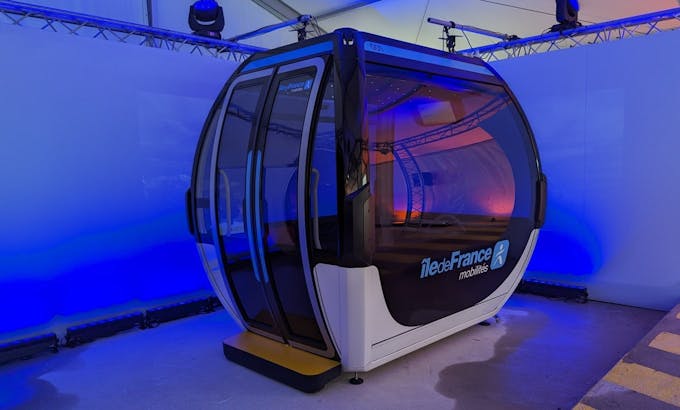C1 cable: discover the prototype of the cabin of the 1st cable car in Île-de-France

You've been waiting for it, it's almost here. Discover today the prototype of the C1 cable cabin, the prototype of which was unveiled on June 22. The first cable car in Île-de-France, the C1 was designed in response to the increased mobility needs of Ile-de-France residents, in an area constrained by numerous urban cuts (roads, marshalling yard, railways, etc.).
Tailor-made and 100% accessible cabins
The C1 cable is not only distinguished by its unique mode of transport. The search for innovation and the proposal of a new experience for users also (and above all!) guided its creation.
Deep customization
Thus, the design of its cabins has been the subject of in-depth customization by the Île-de-France Mobilités teams, in consultation with future users and the manufacturer (Doppel France group). The objective: that the 105 cabins making up the cable car are accessible to all audiences, including people with reduced mobility and children in strollers.
To achieve this, meticulous care has been taken with the interior fittings, with a modularity of 10 seats per cabin, the implementation of priority seats, level access to the stations (zero stairs, zero lifts, zero escalators), screens broadcasting passenger information in real time, Braille and specific safety devices designed for the C1.
Global, responsible and inclusive design
True to its commitments, Île-de-France Mobilités has therefore included the design of the C1 cable in a global, responsible and inclusive design approach. All this, with a strong desire to improve mobility for all, in terms of usefulness, use and operation.
A deliberately oversized carrying capacity
With a carrying capacity of 1,600 people per hour and per direction during peak hours, the C1 cable was designed from the outset to have a greater number of seats than the estimated needs when it was put into service. The objective: to optimize the conditions of comfort and accessibility for passengers, knowing that it will be possible to increase this carrying capacity to 2000 people per hour and per direction, thanks to the addition of 25 cabins.

A controlled environmental footprint
Nothing was left to chance in the development of the C1 cable. The exterior design of the cabins was chosen by the inhabitants of the Ile-de-France region during a consultation in the spring of 2022.
The architecture of the stations has been designed to fit in as well as possible with the urban environment, with sober materials and green roofs. Logical, since the project is guided by a strong sustainable development approach. Thus, its design was certified High Environmental Quality (HQE) – Sustainable Infrastructure in © May 2022 and monitored and controlled actions will be carried out throughout the duration of the work and until commissioning.
In addition, the teams in charge of the project have harmoniously thought out the integration of the C1 cable into the natural and urban landscape, by limiting the footprint of the infrastructures (stations and pylons) in order to adapt to the constraints of the territory.
A response to changes in uses
It's no secret that the population of the Ile-de-France region has increased sharply in recent years. And who says population increase, also says transport offer that must adapt. And this, in a context where soft mobility and intermodality must be favoured to meet environmental challenges.
The C1 cable will connect Créteil to Villeneuve-Saint-Georges via Limeil-Brévannes and Valenton along a route of 4.5 km and 5 stations, with less than 30 seconds between the cabins during rush hour. I
It will thus open up cities, by connecting them to metro 8, and make the territory's nerve centres, such as hospitals, universities and employment areas, more accessible to the 20,000 inhabitants of the area.
The choice of the cable car as a means of transport therefore makes sense to respond to the problems of urban cuts (railway lines, road infrastructure) in this area.

Objective 2025: the next steps of the project
By 2025, users will be able to take a little height! In the meantime, the prototype will still be subject to some evolutions before the start of production of a first series in early 2024. The cabins will then be transported to the workshop-garages of the Temps Durables* station in Limeil-Brévannes for tests scheduled for the 1st half of 2025.
Good news: for the impatients.es, it is already possible to project themselves into the future stations and discover their implementation in the districts.

*The name of the station is provisional.